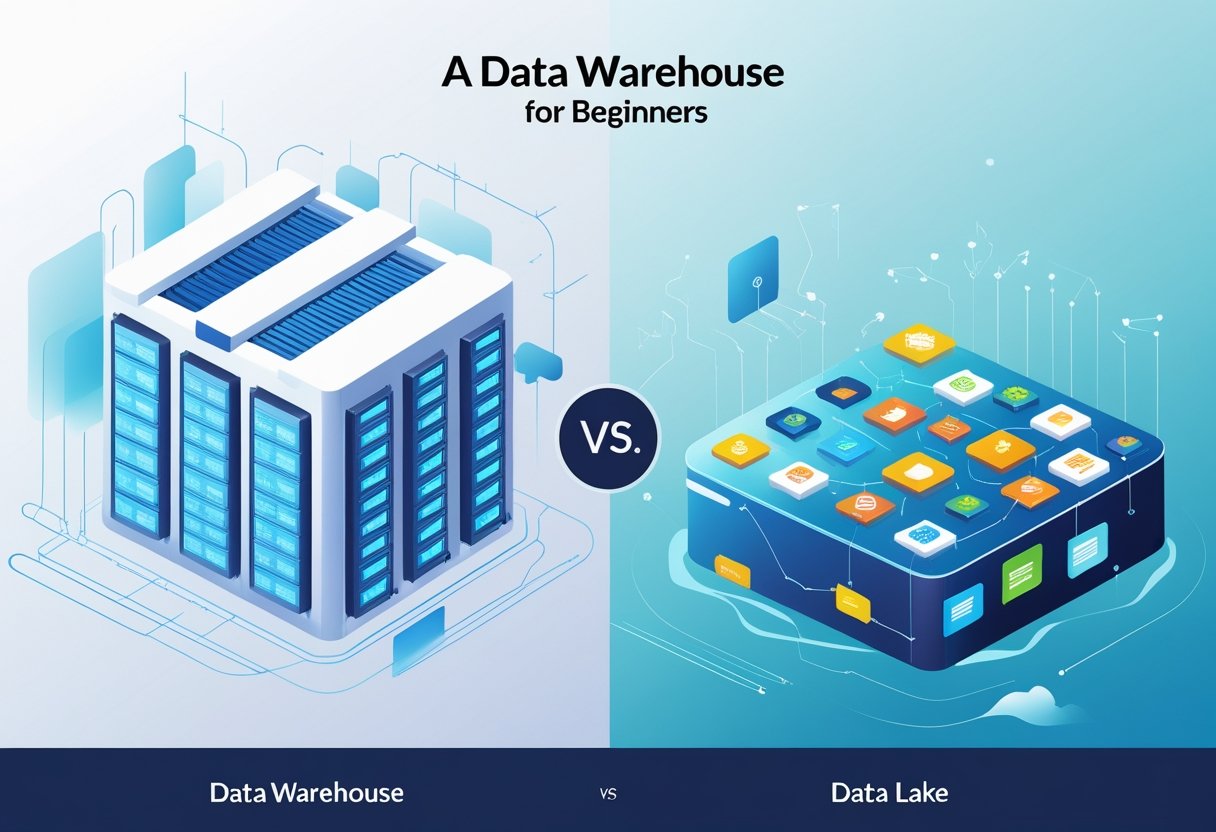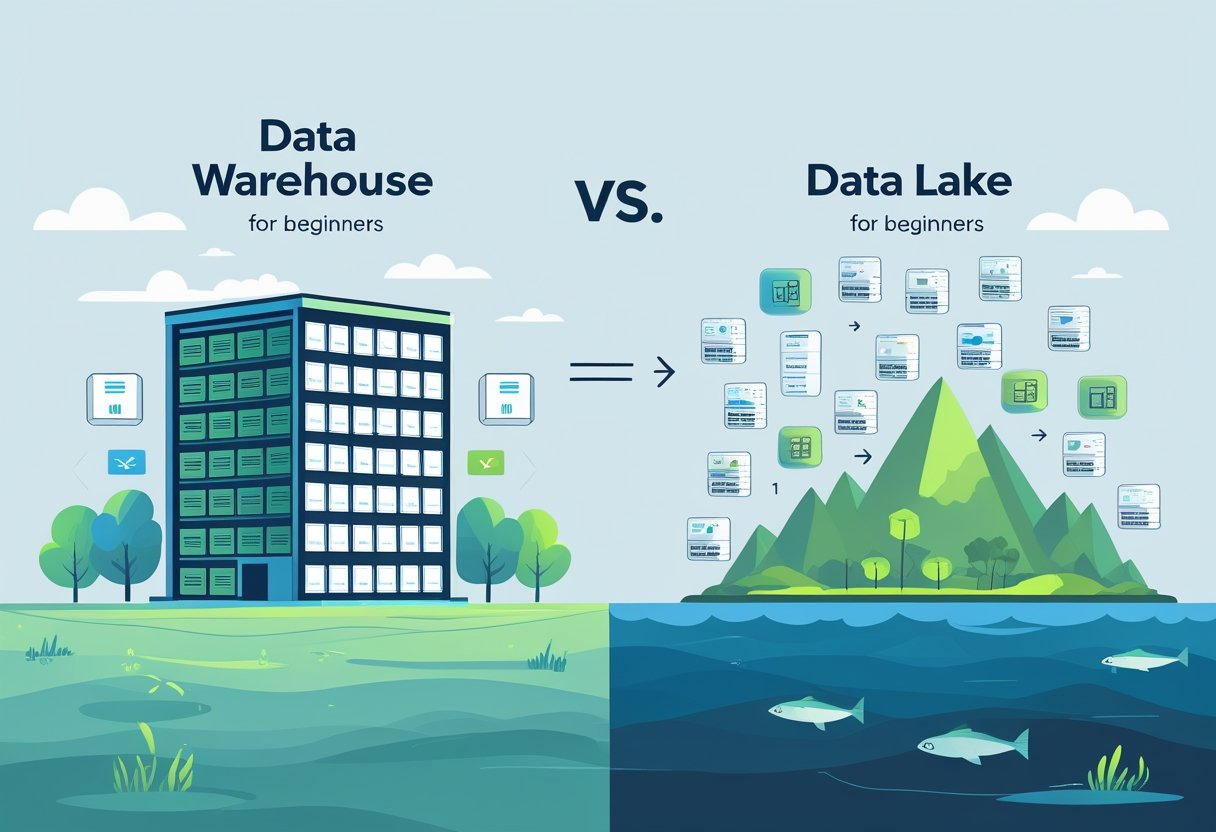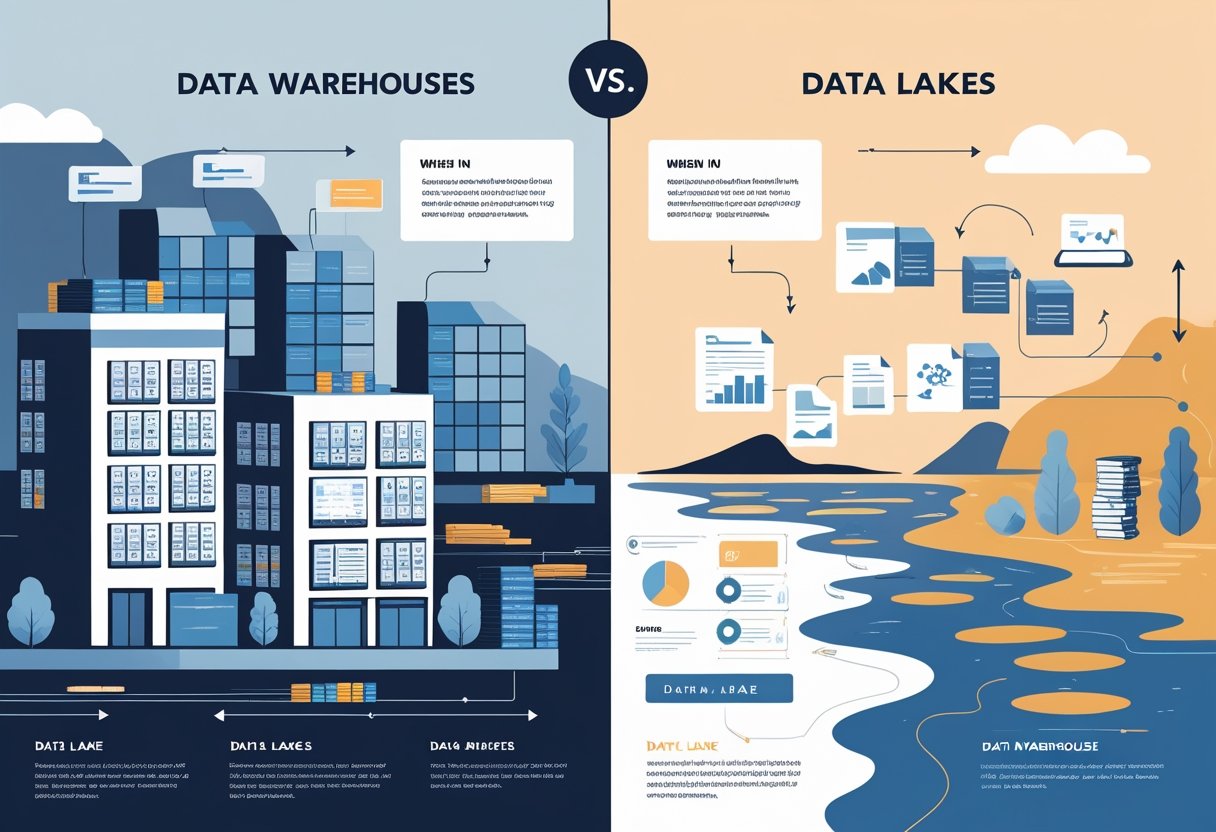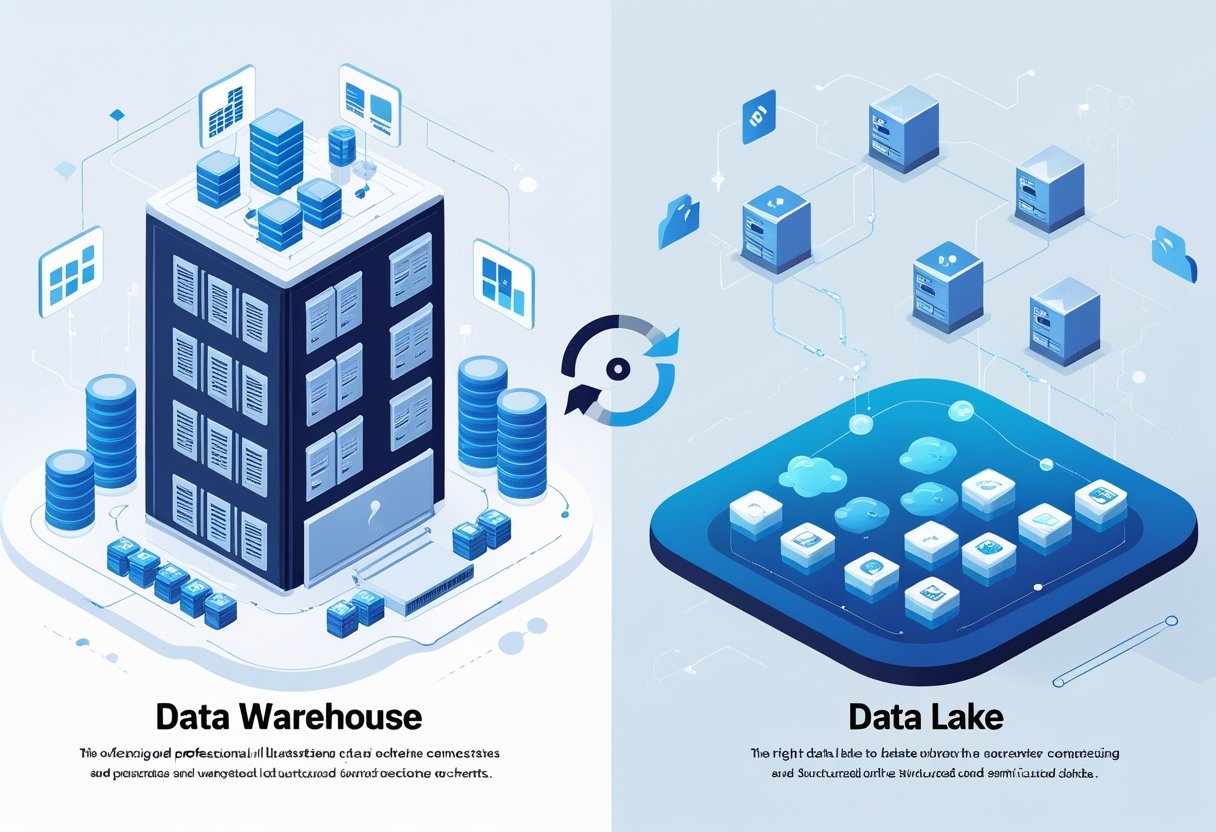Many businesses struggle to understand which data storage solution fits their needs. With so much information flowing into companies every day, choosing between different storage options can feel overwhelming.

A data warehouse stores clean, organized data that’s ready for business reports, while a data lake holds raw data in its original format at a lower cost. Data warehouses and data lakes serve different functions in how organizations manage their information. Each approach has specific strengths that make it better for certain tasks.
Understanding these core differences helps businesses pick the right tool for their goals. This guide breaks down the key concepts, explains when to use each option, and provides clear guidance for making the best choice. Organizations can save time and money by matching their data needs with the right storage solution.
Key Takeaways
- Data warehouses excel at business intelligence with structured data while data lakes handle large volumes of raw data cheaply
- Choose data warehouses for daily business reports and data lakes for machine learning and experimental projects
- Many organizations use both systems together to get the benefits of structured reporting and flexible data storage
Data Warehouse vs Data Lake: Core Concepts

Data warehouses store structured, processed data for business reporting, while data lakes hold raw data in any format for flexible analysis. A newer approach called data lakehouse combines both benefits into one solution.
What Is a Data Warehouse?
A data warehouse is a centralized storage system that holds cleaned and processed data for business analysis. It organizes information in a structured format that makes it easy to find and use.
Data warehouses use a “schema-on-write” approach. This means they apply rules to data before storing it. The system cleans, formats, and organizes information as it enters the warehouse.
Popular data warehouse platforms include Amazon Redshift, Google BigQuery, and Snowflake. These tools excel at running fast queries on structured data.
The main strength of data warehouses lies in their speed and reliability. Business users can quickly generate reports and dashboards. The structured format ensures data consistency across the organization.
However, data warehouses have limitations. They work best with structured data like sales records or customer information. Storing and processing data can be expensive because compute and storage are tightly linked.
What Is a Data Lake?
A data lake stores massive amounts of raw data in its original format without processing it first. It can handle structured, unstructured, and semi-structured data all in one place.
Data lakes use “schema-on-read” technology. They don’t organize data when it enters the system. Instead, users apply structure when they need to analyze the information.
Common data lake platforms include Amazon S3, Azure Data Lake, and Google Cloud Storage. These cloud-based solutions offer low-cost storage that can scale easily.
The biggest advantage of data lakes is flexibility. They can store any type of data including text files, images, videos, and sensor data. Storage costs remain low because compute and storage work separately.
Data lakes face challenges with data quality and governance. Without proper management, they can become “data swamps” where information is hard to find and use.
Data Lakehouse: Bridging the Gap
A data lakehouse combines features of both data warehouses and data lakes into one unified platform. It offers the low-cost storage of a lake with the fast analytics of a warehouse.
Like data lakes, lakehouses can store any type of data at a low cost. Like warehouses, they support fast queries and business intelligence tools. This combination eliminates the need for separate systems.
Modern lakehouse platforms include Databricks, Snowflake, and specialized solutions that use open-source technologies like Delta Lake and Apache Iceberg.
The lakehouse architecture includes multiple layers: ingestion for collecting data, storage for holding information, metadata for organizing content, and consumption for analysis tools.
Organizations can implement lakehouses alongside existing data warehouses and data lakes. This approach allows gradual migration without disrupting current operations.
Key Differences Between Data Warehouses and Data Lakes

Data warehouses store structured data in organized tables, while data lakes hold raw data in any format. Warehouses require data preparation before storage, but lakes accept information as-is and organize it later when needed.
Data Types and Structure
Data warehouses work best with structured data that fits into neat rows and columns. They store information like sales numbers, customer details, and financial records in organized tables.
The data must be cleaned and formatted before it enters the warehouse. This makes it perfect for standard business reports and dashboards.
Data lakes accept all types of information without any preparation. They store structured data, unstructured data like emails and videos, and everything in between.
| Data Warehouse | Data Lake |
|---|---|
| Structured data only | All data types |
| Organized tables | Raw data format |
| Clean, processed | Unprocessed |
Raw data flows directly into lakes from websites, sensors, and mobile apps. Companies can store massive amounts of big data without worrying about format or structure first.
Schema-on-Read vs Schema-on-Write
This difference shows when and how data gets organized for use.
Schema-on-write happens in data warehouses. The data structure gets decided before storage. Data warehouses use an approach called “schema-on-write,” which applies a consistent schema to all data as it is written to storage.
An ETL process transforms the information into the right format. This ETL process takes time but makes data ready for immediate use.
Schema-on-read happens in data lakes. Data lakes use a schema-on-read approach, meaning they do not apply a standard format to incoming data.
The structure gets applied only when someone needs to analyze the data. This approach offers more flexibility but requires extra work during analysis.
Processing and Analytics Use Cases
Data warehouses excel at standard business reporting and BI tools. They power dashboards that track sales, inventory, and customer metrics.
Business analysts use them for regular reports and historical comparisons. The structured format makes it easy to create charts and graphs quickly.
Data lakes support advanced analytics projects that need diverse data types. Data scientists use them for machine learning and artificial intelligence projects.
Big data technologies work well with lakes because they can process huge amounts of unstructured information. Companies use lakes when they want to find patterns in social media posts, customer reviews, or sensor data.
Performance and Cost Considerations
Cost differences favor data lakes for storage but warehouses for immediate use.
Lakes cost less because they use simple storage without processing. Companies can store terabytes of information cheaply in cloud storage systems.
Warehouses cost more upfront because of the ETL process and structured storage. However, they deliver faster results for standard business questions.
Performance varies based on the task. Warehouses answer business questions quickly because data is pre-organized and optimized.
Lakes take longer for analysis because data needs processing first. The trade-off is flexibility versus speed for different types of analytics work.
When and How to Use Data Warehouses and Data Lakes

Different data solutions work best for specific business needs and use cases. Data warehouses excel at business intelligence tasks that need clean, structured data, while data lakes handle complex analytics projects requiring raw data from multiple sources.
Business Intelligence and Reporting
Data warehouses are the best choice for business intelligence and data analytics efforts that business users perform daily. Companies use warehouses when they need fast, reliable reports for decision-making.
The warehouse structure makes data cleaning and preparation automatic. This means business analysts can run queries without worrying about data quality issues.
Key business intelligence uses include:
- Monthly sales reports
- Customer behavior dashboards
- Financial performance tracking
- Inventory management reports
Warehouses work well with transactional data from systems like customer databases and payment platforms. The data gets cleaned and organized before storage, making it ready for immediate analysis.
Business teams can create data visualizations and dashboards quickly. This helps managers make data-driven decisions without waiting for technical teams to prepare the data.
Data Science and Advanced Analytics
Data lakes work better for data science projects that need access to raw, unprocessed information. Data scientists often require large amounts of diverse data for predictive modeling and machine learning projects.
The flexible storage in data lakes allows teams to experiment with different data types. Scientists can combine customer records, social media posts, and image files in the same analysis.
Common data science applications:
- Machine learning model training
- Predictive modeling for customer behavior
- Advanced statistical analysis
- Experimental data research
Data lakes store information without applying strict formatting rules. This gives data scientists the freedom to work with data in its original form and discover patterns that might be lost during data cleaning.
Organizations use data lakes to store data sets for ML, AI and big data analytics workloads, including model training and experimental analytics projects. The low storage costs make it practical to keep large historical datasets for analysis.
Real-Time Data and IoT Integration
Modern businesses need to handle real-time data from sensors, mobile apps, and internet-connected devices. Data lakes handle this streaming information better than traditional warehouses.
Sensor data from manufacturing equipment, website clicks, and mobile app usage flows continuously into data lakes. The system can store this information immediately without waiting for processing.
Real-time data sources include:
- IoT sensor readings
- Website user activity
- Mobile app interactions
- Social media feeds
Data ingestion systems can feed streaming data directly into lakes for immediate storage. Companies can then analyze this information to spot trends and respond to changes quickly.
The separation of data storage and processing power makes lakes more cost-effective for handling large volumes of real-time information. Organizations can scale their storage without increasing computing costs proportionally.
Choosing the Right Solution for Your Needs

The decision between data warehouses and data lakes depends on three main factors: how much data you need to store, how secure it must be, and how much you can spend. Many organizations now use hybrid approaches that combine both systems to get the best results.
Factors to Consider: Scalability, Security, and Cost
Scalability matters most when dealing with big data. Data lakes handle massive amounts of information better than data warehouses. They use cloud storage that grows with your needs.
Data warehouses work well for smaller, structured datasets. They struggle when data volumes get very large. Companies processing terabytes of data daily often choose data lakes for this reason.
Security requirements vary by industry. Data warehouses offer stronger built-in security controls. They have better access management and audit trails.
Data lakes need extra security tools to match warehouse protection levels. Financial and healthcare companies often prefer warehouses for sensitive information.
Cost differences are significant. Data lakes provide lower cost storage using object-based systems. Warehouses cost more due to optimized storage and indexing.
Cloud storage makes data lakes even cheaper. Small businesses with tight budgets often start with lakes and add warehouses later.
Hybrid and Modern Data Architectures
The lakehouse approach combines warehouse speed with lake flexibility. It stores raw data like a lake but processes it like a warehouse.
This data architecture lets companies use both structured reports and machine learning models. Netflix and Uber use lakehouse systems for their data management needs.
Modern platforms offer multiple storage options in one system. They automatically move data between hot and cold storage based on usage patterns.
Cloud-native solutions make hybrid approaches easier to implement. Amazon, Google, and Microsoft provide integrated data storage platforms that switch between lake and warehouse modes.
Companies can start with one approach and gradually add the other. This reduces risk while building complete data management capabilities over time.
Frequently Asked Questions
People often have specific questions about when to use each storage solution and how they compare in real-world situations. These common concerns focus on practical differences, use cases, and newer technologies like data lakehouses.
What are the key differences between a Data Lake and a Data Warehouse?
Data warehouses store structured, cleaned data that follows a specific format. They use a schema-on-write approach, which means data gets organized before storage.
Data lakes store raw data in its original format without any changes. They can hold structured, unstructured, and semi-structured data all in one place.
Data warehouses have built-in analytics tools for running queries and reports. Data lakes need external tools to process and analyze the stored information.
Cost differs significantly between the two options. Data lakes offer cheaper storage but require more work to use the data.
When should one use a Data Lake over a Data Warehouse?
Companies should choose data lakes when they need to store large amounts of diverse data types. This includes text files, images, videos, and sensor data from IoT devices.
Data lakes work best for artificial intelligence and machine learning projects that need access to raw, unprocessed information. Data scientists often prefer this flexibility for experimental work.
Organizations with limited budgets benefit from data lakes’ low-cost storage. They can store all incoming data without knowing its future use.
Companies that collect streaming data in real-time also find data lakes more suitable. The storage can handle continuous data flows without requiring upfront processing.
How does a Data Lakehouse differ from a Data Lake and a Data Warehouse?
A data lakehouse combines features from both data lakes and warehouses into one solution. It stores data in any format like a lake but offers fast querying like a warehouse.
Data lakehouses include a metadata layer that helps organize and track all stored information. This layer enables better data governance than traditional lakes.
Unlike regular data lakes, lakehouses support ACID transactions. These transactions ensure data accuracy and consistency during updates.
Lakehouses can handle both batch processing and real-time streaming data. This flexibility makes them suitable for various business needs.
In what scenarios is a Data Warehouse preferred, and why?
Data warehouses excel at business intelligence and reporting tasks that require consistent, reliable data. Business analysts rely on this structured approach for daily operations.
Companies need warehouses when they want fast SQL queries on historical business data. The pre-processed structure allows for quick analysis and decision-making.
Organizations with strict data governance requirements benefit from warehouses’ built-in quality controls. The schema-on-write approach ensures data consistency.
Warehouses work well for established businesses with predictable reporting needs. They provide reliable performance for routine analytics tasks.
What are the examples of use-cases for Data Lakes?
Companies use data lakes for general-purpose storage when they collect data without knowing its future purpose. This includes social media posts, customer emails, and website clickstreams.
Machine learning teams store training datasets in data lakes. They need access to large volumes of raw data for model development and testing.
Organizations use lakes for data archiving and backup purposes due to their low storage costs. Old transaction records and historical documents fit this category.
Data discovery projects benefit from lakes’ flexibility. Researchers can explore various data types to find patterns and insights without predefined structures.
How do data marts fit into the comparison between Data Lakes and Data Warehouses?
A data mart contains data specific to one business department rather than the entire company. Marketing teams might have their own mart with customer behavior data.
Data marts are actually a type of data warehouse, just smaller and more focused. They follow the same structured, schema-on-write approach as full warehouses.
Companies often feed data from lakes into specialized data marts. This creates a pipeline where raw data gets processed for specific business units.
Data marts provide faster query performance than large warehouses because they contain less data. Departments can access relevant information without searching through company-wide datasets.




